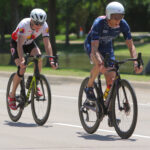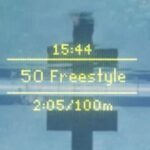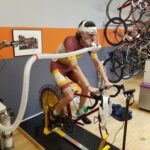When triathletes think about technology, they typically think about HR monitors, bike computers, power meters, GPS, and the like. Yet, sports technology has been around long before the invention of the silicon  chip and the internet. In fact, every advancement that has enabled triathletes to swim (e.g., goggles), bike (e.g., aerobars), and run (e.g., carbon plates) faster is a valuable form of technology. Which brings me to a new piece of swimming technology that is having an immense impact on me as a triathlete, both in terms of gains in swimming speed and the psychology behind my swimming experience.
chip and the internet. In fact, every advancement that has enabled triathletes to swim (e.g., goggles), bike (e.g., aerobars), and run (e.g., carbon plates) faster is a valuable form of technology. Which brings me to a new piece of swimming technology that is having an immense impact on me as a triathlete, both in terms of gains in swimming speed and the psychology behind my swimming experience.
First, a bit of backstory. I didn’t grow up swimming. As a child, I was firmly in the “non-drowning” category when I entered the water. I didn’t do side breathing or swim a lap until well into adulthood. One thing I learned was that there was little chance of catching up to people who grew up swimming and, even more so, who competed in the sport when they were young. These early swimmers developed a relationship with and a feel for the water that is so evident by how they flow so naturally and smoothly through the water.
thing I learned was that there was little chance of catching up to people who grew up swimming and, even more so, who competed in the sport when they were young. These early swimmers developed a relationship with and a feel for the water that is so evident by how they flow so naturally and smoothly through the water.
Given that short-course triathlon (which I now focus on) can come down to seconds or even tenths of seconds (I won the bronze medal in the Super-sprint at the World Championships in Spain last September  by less than a second, but lost out on the silver medal in the Sprint at USAT National in Milwaukee in August by seven seconds), I have been looking for every margin gain to pick up those precious seconds that I have learned can make a big difference in where I stand against the best in the world in my age group.
by less than a second, but lost out on the silver medal in the Sprint at USAT National in Milwaukee in August by seven seconds), I have been looking for every margin gain to pick up those precious seconds that I have learned can make a big difference in where I stand against the best in the world in my age group.
This exploration led me to wetsuits, a fairly obvious area, given my lack of swimming history, in which I might pick up some time (yes, I’m still trying to improve my technique, which will be a topic for a future article in this series). The last few years, I’ve been swimming in a Roka Maverick Pro II, generally considered one of the fastest wetsuits out there. I certainly went faster in the pool and in open water wearing the Roka.
I might pick up some time (yes, I’m still trying to improve my technique, which will be a topic for a future article in this series). The last few years, I’ve been swimming in a Roka Maverick Pro II, generally considered one of the fastest wetsuits out there. I certainly went faster in the pool and in open water wearing the Roka.
Then I watched a video by Santara Technology, the company led by Olav Aleksander Bu, the mastermind  behind the so-called “Norwegian Method” that is all the rage in the triathlon world these days and the coach of Kristian “Blu” Blummenfelt and Gustav “Gus” Iden. I’m a big believer in what Matt Damon stated so beautifully in the film, The Martian, “I’m going to have to science the s&%$ out of this!” So, I was impressed by the empirical rigor that deboer applied to the development of its wetsuits. The video describes the truly scientific approach they were taking to designing a faster wetsuit with deboer.
behind the so-called “Norwegian Method” that is all the rage in the triathlon world these days and the coach of Kristian “Blu” Blummenfelt and Gustav “Gus” Iden. I’m a big believer in what Matt Damon stated so beautifully in the film, The Martian, “I’m going to have to science the s&%$ out of this!” So, I was impressed by the empirical rigor that deboer applied to the development of its wetsuits. The video describes the truly scientific approach they were taking to designing a faster wetsuit with deboer.
So, I ordered deboer’s latest wetsuit, the Fjord 3.0. When I opened the box, it was clear that the Fjord 3.0 was different. It has thick forearms and thin material from the elbow to the shoulders. Most interesting were the “fish scales” that covered most of the suit (based on research into biomicry, which involves learning from and mimicing strategies found in nature to solve human design challenges). As soon as I got in the pool with it on my first “test drive” I knew it was different. I felt like I wasn’t wearing a wetsuit (no tightness, pulling, or constricted movement); I felt like I was gliding through the water like never before. I truly felt like I was channeling Blu and Gus while I swam.
were the “fish scales” that covered most of the suit (based on research into biomicry, which involves learning from and mimicing strategies found in nature to solve human design challenges). As soon as I got in the pool with it on my first “test drive” I knew it was different. I felt like I wasn’t wearing a wetsuit (no tightness, pulling, or constricted movement); I felt like I was gliding through the water like never before. I truly felt like I was channeling Blu and Gus while I swam.
Of course, the real test of a wetsuit is whether it makes us faster, particularly given that all wetsuits make  us faster compared to swimming in just a swimsuit. Global Triathlon Network did a comparison between an Orca wetsuit and a swimsuit in a series of 200y pool swims. They found an eight-second advantage per 100y with a wetsuit compared to a swimsuit.
us faster compared to swimming in just a swimsuit. Global Triathlon Network did a comparison between an Orca wetsuit and a swimsuit in a series of 200y pool swims. They found an eight-second advantage per 100y with a wetsuit compared to a swimsuit.
Last Saturday, I did a pool swim test involving 300y in a swimsuit, 300y in my last year’s Roka Maverick Pro II (still in very good condition), and 300y in my new deboer Fjord 3.0. I swam at a moderate pace (meaning I was pushing a bit, but I was comfortable with my breathing under control) for all three so fatigue would be less of a factor toward the end of my swim test.
The results were striking! Per usual, I averaged 1:55/100y in my swimsuit. Consistent with my past experiences, I swam 1:45/100y in my Roka. And, amazingly, I swam 1:35/100y in my new deboer Fjord 3.0. So, the deboer was a whopping 20s/100y faster than my swimsuit and a surprising 10s/100y over my old Roka, again, considered one of the fastest wetsuits in the world.
experiences, I swam 1:45/100y in my Roka. And, amazingly, I swam 1:35/100y in my new deboer Fjord 3.0. So, the deboer was a whopping 20s/100y faster than my swimsuit and a surprising 10s/100y over my old Roka, again, considered one of the fastest wetsuits in the world.
The Psychology of a Fast Wetsuit
So, based on the results of my decidedly unscientific, though nonetheless compelling, comparison, my new deboer Fjord 3.0 gave me a substantial speed benefit over my Roka. At the same time, given what I do for a living, I’m not just concerned about the literal benefits of the deboer; rather, I’m also intrigued by the psychological benefits of what appears to be a substantially faster wetsuit.
Motivation
Despite not having grown up as a swimmer, over my years of living the triathlon life, I have developed a pretty positive relationship with swimming. I generally enjoy going to the pool and doing my workouts. At the same time, because it is my least competitive discipline within triathlon (I’m always playing catch out of the water), and the one I struggle with most to improve, my motivation can lag sometimes. Additionally, my neighborhood pool is only open from 5:30am-7am during the week, so I have to get up at “0 dark thirty” to swim. In other words, when my alarm rings, I haven’t been too psyched for a swim workout.
Swimming in my deboer Fjord 3.0 (which I do twice a week as I approach the 2024 triathlon season) has been like a shot of motivation. I’m actually excited to head to the pool, even at such an early hour, because I feel that the deboer wetsuit will actually enable me to be competitive against my fast-swimming peers in my age group.
Confidence
This “mental muscle” is where the Fjord 3.0 has really given me a psychological boost. It can get downright discouraging coming out of the water in races well behind the leaders and knowing that, even if I crush it on the bike and run, I will likely run out of “real estate” before I can catch up and pass those ahead of me.
Since getting my deboer wetsuit, I have been aware of a noticeable increase in my confidence. For the first time in my triathlon life, I now believe that I have a chance to close the gap between myself and the fastest swimmers in my age group. Admittedly, I’ll never be on the feet of those fast guys, who grew up swimming and swam competitively in their youth, coming out of the water. But consider my test numbers extrapolated over 400y for a Super-sprint (40 seconds faster) up to an Olympic 1650y (a whopping 2:40m improvement). Even if the time benefit doesn’t transfer 100% to open-water swimming, even half that improvement can be huge.
Emotions
I’m a big believer in the power of emotions in triathlon training and racing. Emotions are fuel that propel us to push harder and go faster. Another thing I have noticed since I started swimming in my Fjord 3.0 is that I am just plain excited to train and race. Plus, the feelings of satisfaction, pride, and inspiration I feel now adds additional fuel to fire (and gives me more matches to burn on race day!) that hopefully will rocket me from start to finish.
In sum, my new motto when I wear my deboer Fjord 3.0 (and all my other really cool triathlon gear) is: “Look fast, feel fast, go fast!”






